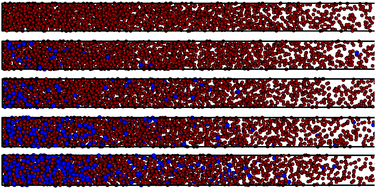Sedimentation equilibria in polydisperse ferrofluids: critical comparisons between experiment, theory, and computer simulation
Abstract
The sedimentation equilibrium of dipolar particles in a ferrofluid is studied using experiment, theory, and computer simulation. A theory of the particle-concentration profile in a dipolar hard-sphere fluid is developed, based on the local-density approximation and accurate expressions from a recently introduced logarithmic free energy approach. The theory is tested critically against Monte Carlo simulation results for monodisperse and bidisperse dipolar hard-sphere fluids in homogeneous gravitational fields. In the monodisperse case, the theory is very accurate over broad ranges of gravitational field strength, volume fraction, and dipolar coupling constant. In the bidisperse case, with realistic dipolar coupling constants and compositions, the theory is excellent at low volume fraction, but is slightly inaccurate at high volume fraction in that it does not capture a maximum in the small-particle concentration profile seen in simulations. Possible reasons for this are put forward. Experimental measurements of the magnetic-susceptibility profile in a real ferrofluid are then analysed using the theory. The concentration profile is linked to the susceptibility profile using the second-order modified mean-field theory. It is shown that the experimental results are not consistent with the sample being monodisperse. By introducing polydispersity in the simplest possible way, namely by assuming the system is a binary mixture, almost perfect agreement between theory and experiment is achieved.


 Please wait while we load your content...
Please wait while we load your content...